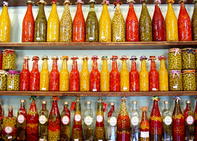Pickles are foods soaked in salty or acidic solutions that help prevent spoilage. It also helps to preserve and change the taste and texture of the food.

Pickling vs Fermenting
The difference between pickled and fermented foods is that pickled products did not undergo a fermentation process caused by beneficial microbes. Fermented products can, however, be pickled in a salt-vinegar solution after the fermentation process. (The topic of fermentation is covered in another article in the Food Processing series).
Pickled Foods
Almost any vegetable, as well as some fruits and other foods, can be pickled. Popular vegetables for pickling include beetroot (blanch to remove the skin), cucumbers, artichokes, peppers, capers, okra, radishes and onions.
Cherry tomatoes can be kept whole, carrots may be peeled and sliced into matchsticks or rounds, while green vegetables such as asparagus or beans are blanched for a few minutes and cooled in ice water before added to the pickling brine.
Pickled fruit includes apples, peaches (blanch to remove skins), lemons, watermelon rind, pineapples and figs. Other foods that benefit from pickling include nasturtiums, fiddlehead ferns, meats such as pork and fish as well as tofu and eggs.
Some cooks add beetroot to the pickling brine of hard-boiled eggs to impart a pink colour to the outer layer of the egg. Avoid cloves as this will turn the pickle liquid brown.
Achar is a spicy Indian pickled condiment made with vinegar, mustard or sesame oils, fruit (e.g. green mango, pineapples, limes) and vegetables (e.g. carrots, cabbage) and spiced with chilli.
How to Pickle
The process of pickling is simple; a pickling brine needs to be made and the food needs to be prepared. Wash containers thoroughly and fill tightly with produce. The hot brine is then poured over and the containers sealed. Cool after sealing and store in a cool dark place.
Some recipes also call for the fresh vegetables to be added to the heating pickling brine. This is then strained (keeping the pickling brine), filled into containers to which the pickling brine is then added.
Recipes vary but a common pickle brine recipe combines equal parts water and vinegar sugar (optional) and salt and the liquid boiled. Spices such as peppercorns, dried coriander seeds, bay leaves and mustard seeds or a special pickling spice can also be added.
Some cooks add beetroot to hard-boiled eggs to impart a pink colour to the outer rind of the pickled egg. Avoid cloves as this will turn the pickle liquid brown. Use a canning or pickling salt. Some salts contain additives that can make the final product cloudy. Do not use ‘reduced-sodium’ salt.
White vinegar, apple cider, white wine, and rice vinegar of 5 percent acidity all work well but avoid using balsamic vinegar. White vinegars will not cause a colour change, but cider vinegar, although it has a mild flavour, it causes pickled foods to darken.
The acetic acid in vinegar limits spoilage micro-organisms, and salts containing calcium, maintain crunchiness in the pickled product.
Fruit or vegetables may be peeled (often the method of blanching is used) and cut into smaller pieces such as matchsticks, slivers or cubs. Large produce cut into smaller pieces allows for quicker absorbing of the pickling liquid.
The fresher and younger the food used, the crunchier the final pickled product.
Discolouration of Pickled Garlic
Garlic contains an enzyme isoallin that reacts with acidity which turns pickled garlic to a blue-green colour. The blue-green discolouration is also caused by using certain metals like copper and cast iron during the cooking process.
Choose older garlic (less isoallin) when pickling, use distilled water (no trace elements like copper) and do not use salt with iodine, like table salt. When pickling garlic, it is recommended to use Kosher salt to limit the discolouration.
Hard water and heavily chlorinated water should be avoided when pickling.
By Marinda Louw